Dachsenfranz
The Dachsenfranz , actually Franzesko Regali (Germanized form of Francesco Regali , places of birth and death as well as dates unknown) was a regionally known original of Italian origin, which was found in the northern Baden region of Kraichgau in the second half of the 19th and the beginning of the 20th century stopped.
The "Dachsenfranz" had fought as a young man with the guerrillas of Giuseppe Garibaldi in the Italian Wars of Independence of the Risorgimento and had fled from there after killing a man - probably a superior - in a dispute. On his flight through Austria, Bavaria and Württemberg he had come to the Kraichgau . He stayed there for around four or five decades and repeatedly made a name for himself in the regional press. According to later understanding, a homeless man who lived in self-dug caves and shelters, he worked in the region as a trapper and pest fighter in farms and mills, which he freed from pests of rats and mice. In the woods he used traps against badgers, foxes, martens and other predators and lived from the sale of the furs and homemade badger fat and herbal medicines. After the outbreak of the First World War he disappeared.
The history of the Dachsenfranz is part of the regional folklore of the Kraichgau. First a beer brand of the brewery "Adler Bräu" was named after him, in the meantime the brewery has been renamed Dachsenfranz Biermanufaktur GmbH & Co KG . In Zuzenhausen , the "Dachsenfranzfest" took place every two years until 2016, a folk festival with a historical character.
Between Horrenberg and Dielheim, a "Dachsenfranzhöhle" was reconstructed in the forest, which is freely accessible and can be visited. In May 2014 the "Dachsenfranz-Wanderweg" from Horrenberg to Zuzenhausen was inaugurated in the Kirchenrückwald .
literature
- Wilhelm Bauer : Franzesko Regali - the Dachsenfranz. An Italian who became the "original" in Kraichgau. In: W. Haas, G. Layer, KH Neser and H. Rückert: Our country. Home calendar for Neckar Valley, Odenwald, building land and Kraichgau. Rhein-Neckar-Zeitung , Heidelberg 2007, ISBN 3-936866-07-4 , p. 71ff.
- Markus M. Wieland: The badger Franz. In: This country. Baden and other things from the Rhine, Neckar and Main. 16th year, issue 2/2001, Karlsruhe 2001, ISSN 0930-4878 , p. 34ff.
Web links
- Via Dachsenfranz on the side of the brewery named after him
- To the Dachsenfranzfest and the history of the Dachsenfranz on the official website of the municipality of Zuzenhausen
- About the Dachsenfranz on the side of the Dielheimer district Balzfeld
- The Dachsenfranz on morr-siedelsbrunn.de
Remarks
- ↑ a b The sources contradict each other with regard to the exact times. Sometimes there is talk of 1860, sometimes of 1866, its appearance in Kraichgau is sometimes only settled around 1870.
- ↑ “Sleeping in bed has been unknown to him for 40 years; At Mother Green's or in a stable room , he lays his tired head down to rest. ”Wilhelm Bauer, Franzesko Regali - the Dachsenfranz. An Italian who became the "original" in Kraichgau. In: W. Haas, G. Layer, KH Neser and H. Rückert: Our country. Home calendar for Neckar Valley, Odenwald, building land and Kraichgau. Rhein-Neckar-Zeitung , Heidelberg 2007, p. 73.
- ^ Off for the Dachsenfranzfest in Zuzenhausen . ( rnz.de [accessed on May 8, 2018]).
- ↑ “In the footsteps of the legendary Dachsenfranz in the Kirchenrückwald” in the Rhein-Neckar-Zeitung of May 20, 2014, accessed on May 31, 2017
| personal data | |
|---|---|
| SURNAME | Dachsenfranz |
| ALTERNATIVE NAMES | Regali, Francesco (real name); Regali, Franzesko |
| BRIEF DESCRIPTION | Italian city original |
| DATE OF BIRTH | 19th century |
| PLACE OF BIRTH | Italy |
| DATE OF DEATH | 20th century |



